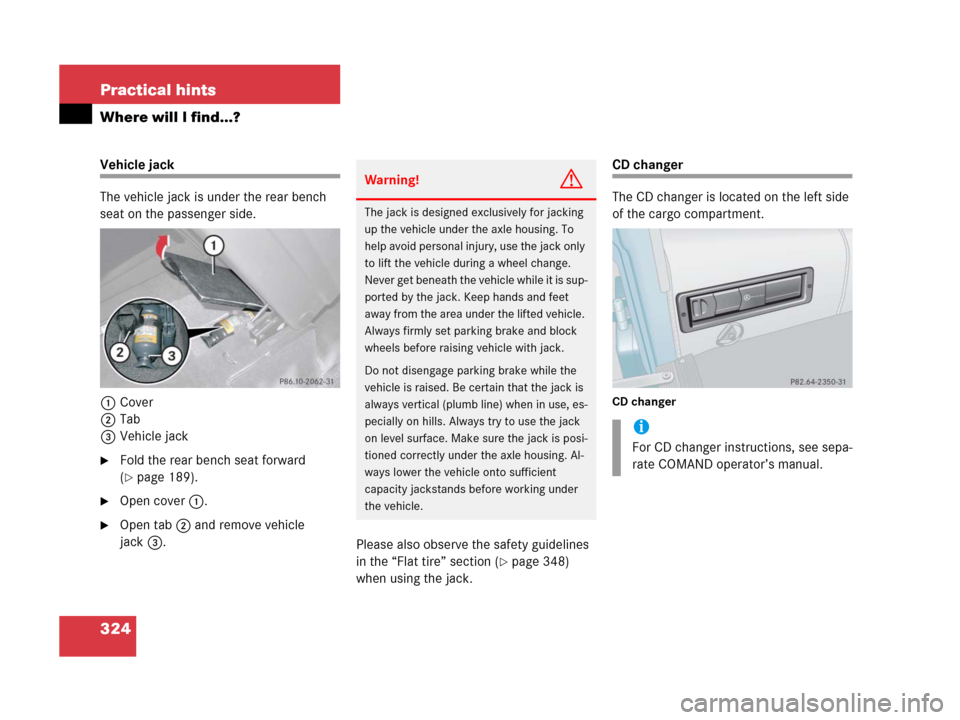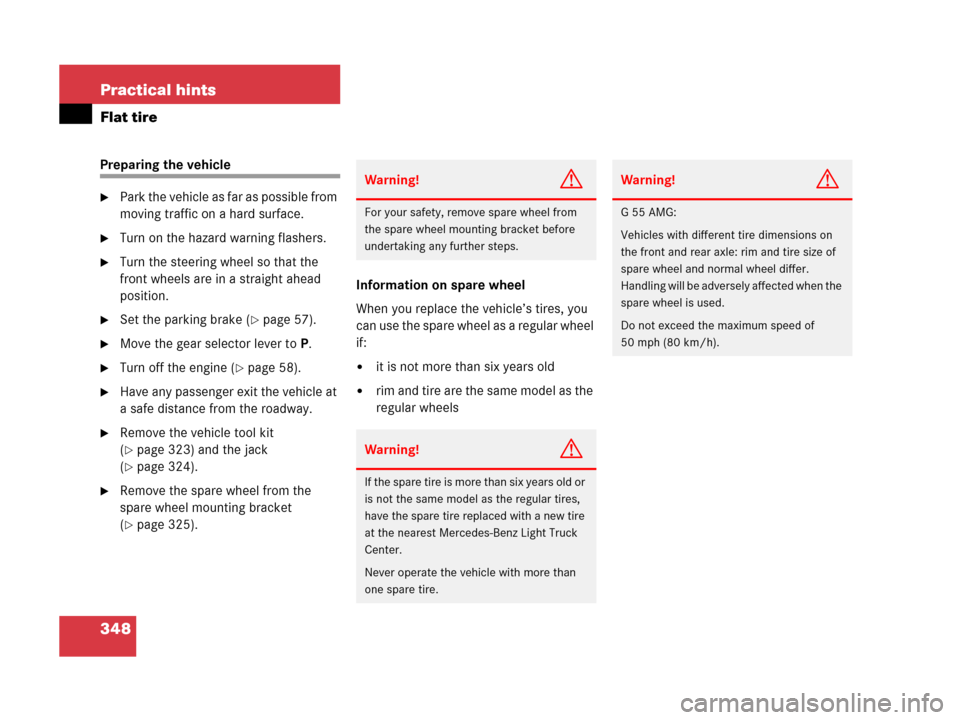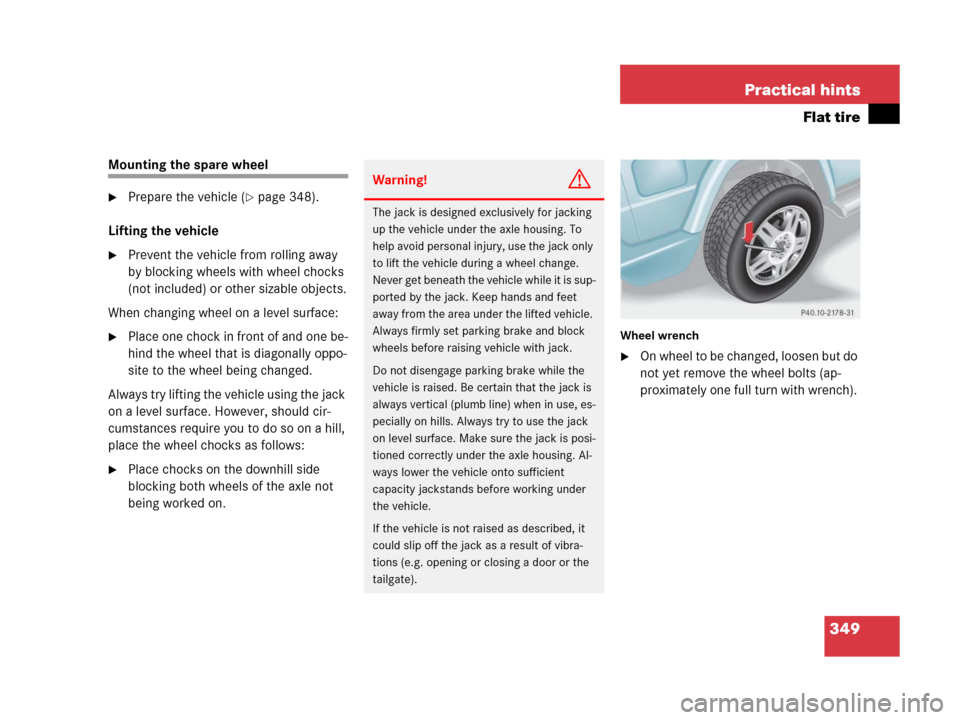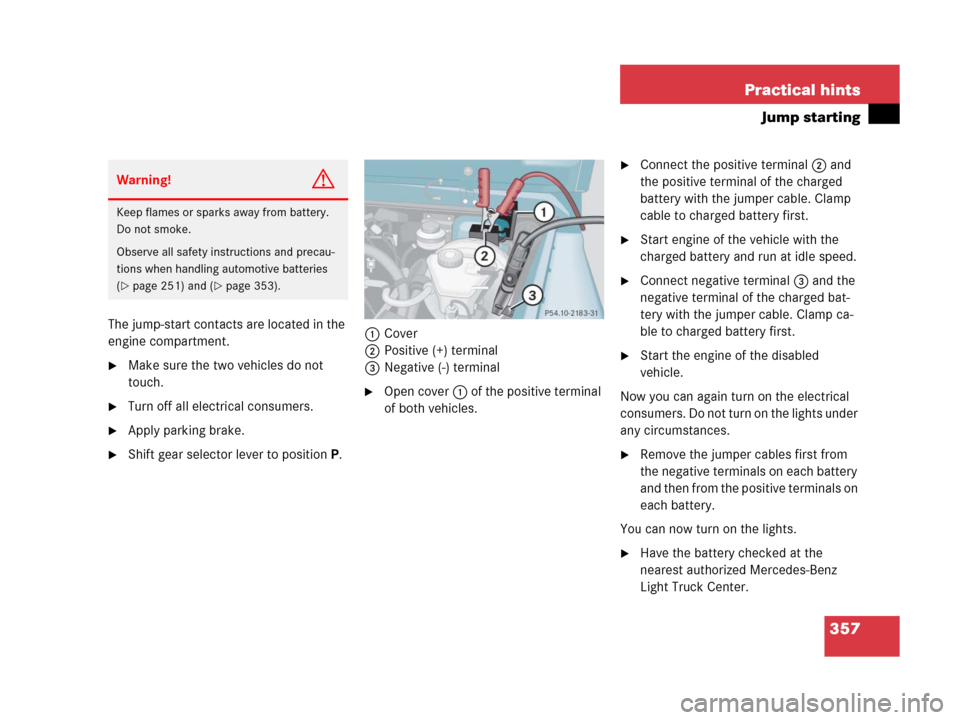Page 321 of 417
320 Practical hints
What to do if …
Display symbolDisplay messagePossible causePossible solution
DRIVE TO WORKSHOP!The seat belt system is malfunctioning.�Visit an authorized Mercedes-Benz
Light Truck Center as soon as
possible.
§TC IN NEUTRALNo gear has been selected in the transfer
case, it is in NEUTRAL.�Engage transfer case to gear position
HIGH or LOW (
�page 157).
Warning!G
If the transfer case is in NEUTRAL, the
Pposition of the transmission will not hold
the vehicle. The parking brake must be ap-
plied to hold vehicle in place.
Page 325 of 417

324 Practical hints
Where will I find...?
Vehicle jack
The vehicle jack is under the rear bench
seat on the passenger side.
1Cover
2Tab
3Vehicle jack
�Fold the rear bench seat forward
(
�page 189).
�Open cover1.
�Open tab2 and remove vehicle
jack3.
Please also observe the safety guidelines
in the “Flat tire” section (
�page 348)
when using the jack.
CD changer
The CD changer is located on the left side
of the cargo compartment.
CD changer
Warning!G
The jack is designed exclusively for jacking
up the vehicle under the axle housing. To
help avoid personal injury, use the jack only
to lift the vehicle during a wheel change.
Never get beneath the vehicle while it is sup-
ported by the jack. Keep hands and feet
away from the area under the lifted vehicle.
Always firmly set parking brake and block
wheels before raising vehicle with jack.
Do not disengage parking brake while the
vehicle is raised. Be certain that the jack is
always vertical (plumb line) when in use, es-
pecially on hills. Always try to use the jack
on level surface. Make sure the jack is posi-
tioned correctly under the axle housing. Al-
ways lower the vehicle onto sufficient
capacity jackstands before working under
the vehicle.
i
For CD changer instructions, see sepa-
rate COMAND operator’s manual.
Page 337 of 417
336 Practical hints
Replacing bulbs
Bulbs Front lamps Rear lamps
LampType
1Additional turn
signal lampLED
2Turn signal lamp1156 NA
3Side marker lampT 4 W
4High and low beamH4 60 (55 W)
Parking and
standing lampT 4 W
5Fog lampH3 (55 W)
LampType
6High mounted brake
lampLED
7Turn signal lampPY 21 W
Brake lampP 21 W
Tail, parking and
standing lampR 5 W
8Backup lampP 21 W
9License plate lampsC 5 W
aRear fog lampP 21 W
bSide marker lampT 4 W
Page 349 of 417

348 Practical hints
Flat tire
Preparing the vehicle
�Park the vehicle as far as possible from
moving traffic on a hard surface.
�Turn on the hazard warning flashers.
�Turn the steering wheel so that the
front wheels are in a straight ahead
position.
�Set the parking brake (�page 57).
�Move the gear selector lever toP.
�Turn off the engine (�page 58).
�Have any passenger exit the vehicle at
a safe distance from the roadway.
�Remove the vehicle tool kit
(
�page 323) and the jack
(
�page 324).
�Remove the spare wheel from the
spare wheel mounting bracket
(
�page 325).Information on spare wheel
When you replace the vehicle’s tires, you
can use the spare wheel as a regular wheel
if:
�it is not more than six years old
�rim and tire are the same model as the
regular wheels
Warning!G
For your safety, remove spare wheel from
the spare wheel mounting bracket before
undertaking any further steps.
Warning!G
If the spare tire is more than six years old or
is not the same model as the regular tires,
have the spare tire replaced with a new tire
at the nearest Mercedes-Benz Light Truck
Center.
Never operate the vehicle with more than
one spare tire.
Warning!G
G55AMG:
Vehicles with different tire dimensions on
the front and rear axle: rim and tire size of
spare wheel and normal wheel differ.
Handling will be adversely affected when the
spare wheel is used.
Do not exceed the maximum speed of
50 mph (80 km/h).
Page 350 of 417

349 Practical hints
Flat tire
Mounting the spare wheel
�Prepare the vehicle (�page 348).
Lifting the vehicle
�Prevent the vehicle from rolling away
by blocking wheels with wheel chocks
(not included) or other sizable objects.
When changing wheel on a level surface:
�Place one chock in front of and one be-
hind the wheel that is diagonally oppo-
site to the wheel being changed.
Always try lifting the vehicle using the jack
on a level surface. However, should cir-
cumstances require you to do so on a hill,
place the wheel chocks as follows:
�Place chocks on the downhill side
blocking both wheels of the axle not
being worked on.
Wheel wrench
�On wheel to be changed, loosen but do
not yet remove the wheel bolts (ap-
proximately one full turn with wrench).
Warning!G
The jack is designed exclusively for jacking
up the vehicle under the axle housing. To
help avoid personal injury, use the jack only
to lift the vehicle during a wheel change.
Never get beneath the vehicle while it is sup-
ported by the jack. Keep hands and feet
away from the area under the lifted vehicle.
Always firmly set parking brake and block
wheels before raising vehicle with jack.
Do not disengage parking brake while the
vehicle is raised. Be certain that the jack is
always vertical (plumb line) when in use, es-
pecially on hills. Always try to use the jack
on level surface. Make sure the jack is posi-
tioned correctly under the axle housing. Al-
ways lower the vehicle onto sufficient
capacity jackstands before working under
the vehicle.
If the vehicle is not raised as described, it
could slip off the jack as a result of vibra-
tions (e.g. opening or closing a door or the
tailgate).
Page 358 of 417

357 Practical hints
Jump starting
The jump-start contacts are located in the
engine compartment.
�Make sure the two vehicles do not
touch.
�Turn off all electrical consumers.
�Apply parking brake.
�Shift gear selector lever to positionP.1Cover
2Positive (+) terminal
3Negative (-) terminal
�Open cover1 of the positive terminal
of both vehicles.
�Connect the positive terminal2 and
the positive terminal of the charged
battery with the jumper cable. Clamp
cable to charged battery first.
�Start engine of the vehicle with the
charged battery and run at idle speed.
�Connect negative terminal3 and the
negative terminal of the charged bat-
tery with the jumper cable. Clamp ca-
ble to charged battery first.
�Start the engine of the disabled
vehicle.
Now you can again turn on the electrical
consumers. Do not turn on the lights under
any circumstances.
�Remove the jumper cables first from
the negative terminals on each battery
and then from the positive terminals on
each battery.
You can now turn on the lights.
�Have the battery checked at the
nearest authorized Mercedes-Benz
Light Truck Center.
Warning!G
Keep flames or sparks away from battery.
Do not smoke.
Observe all safety instructions and precau-
tions when handling automotive batteries
(
�page 251) and (�page 353).
Page 392 of 417

391 Index
Battery, vehicle 251, 353
Charging 353
Disconnecting 354
Messages in display 304, 305
Reconnecting 355
Bead 273
Block heater (Canada only) 279
Blocking rear door window operation 78
B-pillar 368
Brake assist system (BAS) 383
Brake fluid 241, 378
Brake lamp bulbs, left and right 336
Brake lamp, high mounted 336
Brake pads
Message in display 305
Brakes 221
Warning lamp 292, 293
Break-in period 218
Brush guard* 331
Lowering 332
Raising and securing 332Bulbs, replacing
Additional turn signals 336
Backup lamps 336, 344
Brake lamps 336, 344
Front fog lamps 336, 340
Front lamps 335, 336
Front turn signal lamps 336, 342
High and low beam 338
High beam lamps 336
High mounted brake lamp 336
License plate lamps 336, 345
Low beam lamps 336
Parking lamps 336, 338
Rear fog lamp 336, 344
Rear turn signal lamps 336
Side marker lamps 336, 342
Standing lamps 336, 338
Tail lamp assemblies 336
Tail lamp unit 343C
CAC (Customer Assistance Center) 383
Call priority
Tele Aid 208
Calling up
Maintenance service indicator 281
Range (distance to empty) 146
CAN system 383
Capacities
Fuels, coolants, lubricants, etc. 376
Cargo area see Cargo compartment
Cargo compartment
Tailgate 97, 98
Tie-down rings 193
Cargo compartment cover 187
Installing 187
Removing 187
Cargo tie-down rings 193
Catalytic converter 236
CD changer 324
CD player
Operating 130
Page 400 of 417

399 Index
Kickdown (Automatic transmission) 153
Kilometers/miles in speedometer 137
Kilopascal 274
Km/h or mph in speedometer 137
L
Labels, identification 368
Lamp bulbs, exterior 335
Lamps, exterior
Front 336
Light sensor 316
Messages in display 314, 316
Rear 336
Replacing bulbs for rear 343
Lamps, indicator and warning
ABS 290, 291
Battery (SmartKey) 94
Brakes 292, 293
CHECK ENGINE 294
Engine diagnostics 294
ESP 295
Fuel reserve 296
Instrument cluster 296
Maintenance service indicator 280
Seat belts 296
SRS 63
Turn signals 25Language
Multifunction display 137
Setting 137
LATCH child seat anchors 77
Layout of poly-V-belt drive 369
Leather upholstery
Cleaning 288
License plate lamps
Messages in display 316
Replacing bulbs 336, 345
Light alloy wheels
Cleaning 287
Technical data 372, 373
Light sensor 316
Lighter see Cigarette lighter
Lighting 110
Automatic headlamp mode 111
Combination switch 114
Daytime running lamp mode 112
Exterior lamp switch 110
Front fog lamps 113
High beam flasher 114
High beams 114
Instrument cluster illumination 120
Interior 116
Locator lighting 113Low beams 110
Manual headlamp mode 111
Night security illumination 113
Parking lamps 110
Rear fog lamp 114
Settings (control system) 138
Limiting the gear range 154
Limp Home Mode 156
Line of fall 385
Loading 187
Cargo compartment cover 187
Cargo tie-down rings 193
Instructions 192
Partition net* 189
Roof rack 187
Split rear bench seat 188
Loading terminology 273
Loading the vehicle 255
Locator lighting 113
Setting 139
Locking 57, 92
Fuel filler flap 239
Global, SmartKey 94
Vehicle in an emergency 328
Locking knob 385
Loss of keys 96